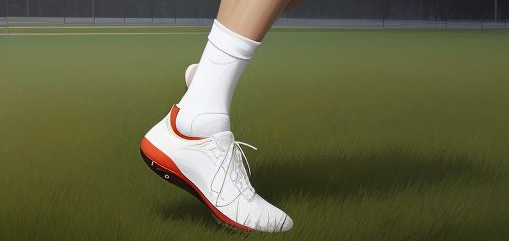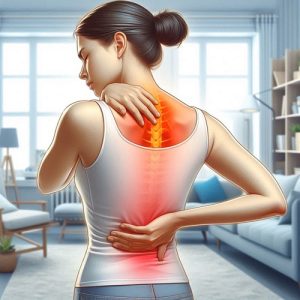Heel Pain No More: Exploring the Best Treatments for Haglund’s Deformity
Haglund’s deformity is a common cause of heel pain, characterized by a bony enlargement at the back of the heel where the Achilles tendon attaches to the calcaneus (heel bone). This condition is also referred to as a “pump bump” due to its association with wearing tight shoes, such as high heels, which exacerbate the condition. In this comprehensive article, we will explore various treatments for Haglund’s deformity, focusing on both non-surgical and surgical approaches. We’ll also highlight how lifestyle adjustments, including posture and ergonomic habits, play a role in managing heel pain and overall health.
Introduction
Heel pain can be debilitating, affecting daily activities and quality of life. For individuals suffering from Haglund’s deformity, this discomfort often originates from the back of the heel, leading to irritation, swelling, and difficulty walking. As a physiotherapist, it’s essential to guide patients through their recovery journey, ensuring they understand the best practices for pain relief and long-term foot health.
In this article, we’ll discuss Haglund’s deformity treatments and highlight ways to manage pain, including orthotic inserts, heel cups, shoe modifications, and stretching exercises. Our goal is to help patients take control of their condition and lead pain-free lives while also integrating holistic lifestyle habits like proper posture and ergonomics. Let’s delve into the causes of Haglund’s deformity and the various ways to manage and treat this condition.
Understanding Haglund’s Deformity – Causes and Symptoms
Haglund’s deformity arises when the bony prominence on the back of the heel becomes irritated, often due to friction from footwear. Over time, this irritation causes inflammation, pain, and swelling.
Key Factors Leading to Haglund’s Deformity:
- Footwear: Shoes with rigid backs, such as high heels or tight-fitting footwear, are major contributors. These shoes put pressure on the heel and irritate the bony prominence.
- Foot Structure: People with high arches or a tight Achilles tendon are more prone to developing Haglund’s deformity. The altered foot mechanics cause increased pressure on the heel bone.
- Excessive Activity: Running or engaging in activities that stress the Achilles tendon can exacerbate the condition.
- Achilles Tendon Involvement: The condition can be aggravated by inflammation of the Achilles tendon, contributing to pain at the back of the heel.
Common Symptoms:
- Swelling and redness at the back of the heel
- Pain when wearing certain shoes
- Difficulty walking or running
- Tenderness around the heel
- Heel bursitis (inflammation of the bursa, a fluid-filled sac between the tendon and bone)
Diagnosis:
Diagnosis typically involves a physical exam and imaging tests, such as X-rays, to determine the severity of the deformity and rule out other potential causes of heel pain.
Non-Surgical Treatments for Haglund’s Deformity
1. Heel Pain Relief: Ice Therapy and Anti-Inflammatory Medications
For immediate relief from inflammation and pain, ice therapy can be applied to the Achilles not directly to the heel to reduce swelling. Patients are encouraged to ice for 10-15 minutes several times a day. In conjunction with this, non-steroidal anti-inflammatory drugs (NSAIDs) like ibuprofen are effective in managing pain and reducing inflammation[1].
2. Orthotic Inserts and Heel Cups
Orthotic devices, such as custom-made inserts or heel cups, help redistribute pressure on the heel. By cushioning the bony prominence, they reduce irritation and pain, making walking more comfortable[6]. Heel cups also offer support and protection, particularly for patients with high arches or tight Achilles tendons.
3. Shoe Modifications
Footwear plays a crucial role in managing Haglund’s deformity. Patients should avoid shoes with rigid backs and high heels. Instead, opt for shoes with a soft heel counter, proper cushioning, and a slightly elevated heel to reduce strain on the Achilles tendon. Custom-made orthotics can further adjust the pressure distribution on the foot if necessary.
4. Achilles Tendon Stretching Exercises
Since a tight Achilles tendon is a significant contributor to Haglund’s deformity, stretching exercises are vital. Regular stretching can help elongate the tendon and relieve pressure on the heel. Simple stretches like calf stretches against a wall and towel stretches can significantly improve flexibility and reduce symptoms. This 20-minute daily routine can make a substantial difference:
| Time | Exercise | Instructions |
|---|---|---|
| 5 min | Calf Stretch (Wall) | Stand with your hands on a wall. Step one leg back and keep the heel on the ground. Bend the front knee to stretch the back leg’s calf. Hold for 30 sec. |
| 5 min | Towel Stretch | Sit with legs extended. Wrap a towel around your foot and pull gently to stretch the Achilles tendon. Hold for 30 seconds per foot. |
| 5 min | Heel Raises | Stand on the edge of a step with your heels hanging off. Slowly raise your heels up and down, strengthening and stretching the Achilles tendon. |
| 5 min | Seated Calf Stretch | Sit on the ground with your legs extended. Use your hands to pull your toes towards you for a deeper stretch. Hold for 30 seconds on each leg. |
For more samples click here.
5. Heel Lifts and Footwear Changes
Heel lifts can be inserted into shoes to reduce the strain on the Achilles tendon and lessen pressure on the bony prominence at the back of the heel. Elevating the heel and lifting the heel help alleviate tension, allowing the tendon to heal[4].
Surgical Treatments for Severe Cases of Haglund’s Deformity
For patients who don’t respond to conservative treatments, surgical options may be considered. Surgery aims to remove the bony prominence and relieve pressure on the Achilles tendon. There are several surgical techniques available depending on the severity of the deformity.
1. Endoscopic Surgery
In less severe cases, a minimally invasive endoscopic procedure can be performed to shave down the bony prominence. This option has a shorter recovery time compared to traditional open surgery.
2. Open Surgery
In more severe cases, traditional open surgery is required to remove the excess bone from the heel. During the procedure, the surgeon may also address any damage to the Achilles tendon or remove inflamed tissue surrounding the area.
3. Post-Surgical Recovery
Post-surgery, patients will need to undergo a rehabilitation program, including physical therapy, to regain strength and mobility in the affected foot. Recovery typically takes a few weeks, during which patients must avoid putting excessive weight on the heel.
Long-Term Management and Preventive Strategies
1. Physical Therapy for Rehabilitation
Post-surgery or during non-surgical treatment, physical therapy plays a pivotal role in rehabilitation. A therapist will design a personalized program to improve flexibility, strengthen the Achilles tendon, and restore proper biomechanics in the foot. This includes manual therapy, stretches, and strengthening exercises[5].
2. Lifestyle Modifications
In addition to physical treatments, lifestyle adjustments are crucial. Prolonged use of smartphones, tablets, or computers can lead to poor posture, which in turn affects foot health. Maintaining proper posture while sitting, standing, or walking can alleviate undue stress on the feet.
Tips for Improved Ergonomics and Lifestyle Habits:
- Posture Awareness: Maintain a straight posture with feet flat on the ground while using devices.
- Regular Breaks: Take breaks every 20-30 minutes to walk and stretch your legs.
- Foot Support: Ensure ergonomic seating with proper foot support to reduce strain on the lower body.
By integrating these habits into daily life, patients can not only manage Haglund’s deformity but also prevent other musculoskeletal issues that arise from poor posture.
Trustworthy Sources and Credibility in Treatment
When seeking treatment for Haglund’s deformity, it’s important to consult with certified professionals, such as podiatrists and physiotherapists, who specialize in foot and ankle conditions. Trusted healthcare providers will ensure a comprehensive approach to managing symptoms, from initial diagnosis to long-term rehabilitation. Patients should prioritize clinics that offer multidisciplinary care, combining orthopedics, physical therapy, and personalized treatment plans.
By making the appropriate lifestyle changes and following a guided treatment plan, individuals can manage their symptoms and prevent further complications. If you or a loved one is struggling with heel pain, consider seeking professional advice from a healthcare provider experienced in treating Haglund’s deformity.
If you found this information helpful, share this article with friends or family who might be suffering from heel pain. Feel free to leave a comment or contact a professional for personalized advice on managing your foot health.

Non-Surgical Treatments for Haglund’s Deformity
1. Heel Pain Relief: Ice Therapy and Anti-Inflammatory Medications
For immediate relief from inflammation and pain, ice therapy can be applied to the Achilles not directly to the heel to reduce swelling. Patients are encouraged to ice for 10-15 minutes several times a day. In conjunction with this, non-steroidal anti-inflammatory drugs (NSAIDs) like ibuprofen are effective in managing pain and reducing inflammation[1].
2. Orthotic Inserts and Heel Cups
Orthotic devices, such as custom-made inserts or heel cups, help redistribute pressure on the heel. By cushioning the bony prominence, they reduce irritation and pain, making walking more comfortable[6]. Heel cups also offer support and protection, particularly for patients with high arches or tight Achilles tendons.
3. Shoe Modifications
Footwear plays a crucial role in managing Haglund’s deformity. Patients should avoid shoes with rigid backs and high heels. Instead, opt for shoes with a soft heel counter, proper cushioning, and a slightly elevated heel to reduce strain on the Achilles tendon. Custom-made orthotics can further adjust the pressure distribution on the foot if necessary.

4. Achilles Tendon Stretching Exercises
Since a tight Achilles tendon is a significant contributor to Haglund’s deformity, stretching exercises are vital. Regular stretching can help elongate the tendon and relieve pressure on the heel. Simple stretches like calf stretches against a wall and towel stretches can significantly improve flexibility and reduce symptoms. This 20-minute daily routine can make a substantial difference:
| Time | Exercise | Instructions |
|---|---|---|
| 5 min | Calf Stretch (Wall) | Stand with your hands on a wall. Step one leg back and keep the heel on the ground. Bend the front knee to stretch the back leg’s calf. Hold for 30 sec. |
| 5 min | Towel Stretch | Sit with legs extended. Wrap a towel around your foot and pull gently to stretch the Achilles tendon. Hold for 30 seconds per foot. |
| 5 min | Heel Raises | Stand on the edge of a step with your heels hanging off. Slowly raise your heels up and down, strengthening and stretching the Achilles tendon. |
| 5 min | Seated Calf Stretch | Sit on the ground with your legs extended. Use your hands to pull your toes towards you for a deeper stretch. Hold for 30 seconds on each leg. |
For more samples click here.
5. Heel Lifts and Footwear Changes
Heel lifts can be inserted into shoes to reduce the strain on the Achilles tendon and lessen pressure on the bony prominence at the back of the heel. Elevating the heel and lifting the heel help alleviate tension, allowing the tendon to heal[4].
Surgical Treatments for Severe Cases of Haglund’s Deformity
For patients who don’t respond to conservative treatments, surgical options may be considered. Surgery aims to remove the bony prominence and relieve pressure on the Achilles tendon. There are several surgical techniques available depending on the severity of the deformity.
1. Endoscopic Surgery
In less severe cases, a minimally invasive endoscopic procedure can be performed to shave down the bony prominence. This option has a shorter recovery time compared to traditional open surgery.
2. Open Surgery
In more severe cases, traditional open surgery is required to remove the excess bone from the heel. During the procedure, the surgeon may also address any damage to the Achilles tendon or remove inflamed tissue surrounding the area.
3. Post-Surgical Recovery
Post-surgery, patients will need to undergo a rehabilitation program, including physical therapy, to regain strength and mobility in the affected foot. Recovery typically takes a few weeks, during which patients must avoid putting excessive weight on the heel.
Long-Term Management and Preventive Strategies
1. Physical Therapy for Rehabilitation
Post-surgery or during non-surgical treatment, physical therapy plays a pivotal role in rehabilitation. A therapist will design a personalized program to improve flexibility, strengthen the Achilles tendon, and restore proper biomechanics in the foot. This includes manual therapy, stretches, and strengthening exercises[5].
2. Lifestyle Modifications
In addition to physical treatments, lifestyle adjustments are crucial. Prolonged use of smartphones, tablets, or computers can lead to poor posture, which in turn affects foot health. Maintaining proper posture while sitting, standing, or walking can alleviate undue stress on the feet.
Tips for Improved Ergonomics and Lifestyle Habits:
- Posture Awareness: Maintain a straight posture with feet flat on the ground while using devices.
- Regular Breaks: Take breaks every 20-30 minutes to walk and stretch your legs.
- Foot Support: Ensure ergonomic seating with proper foot support to reduce strain on the lower body.
By integrating these habits into daily life, patients can not only manage Haglund’s deformity but also prevent other musculoskeletal issues that arise from poor posture.
Trustworthy Sources and Credibility in Treatment
When seeking treatment for Haglund’s deformity, it’s important to consult with certified professionals, such as podiatrists and physiotherapists, who specialize in foot and ankle conditions. Trusted healthcare providers will ensure a comprehensive approach to managing symptoms, from initial diagnosis to long-term rehabilitation. Patients should prioritize clinics that offer multidisciplinary care, combining orthopedics, physical therapy, and personalized treatment plans.
By making the appropriate lifestyle changes and following a guided treatment plan, individuals can manage their symptoms and prevent further complications. If you or a loved one is struggling with heel pain, consider seeking professional advice from a healthcare provider experienced in treating Haglund’s deformity.
If you found this information helpful, share this article with friends or family who might be suffering from heel pain. Feel free to leave a comment or contact a professional for personalized advice on managing your foot health.


